Eco-Friendly Recycling of Lithium Batteries for Extraction of High-Purity Metals
Abstract
1. Introduction
2. Materials and Methods
2.1. Materials
2.2. Methods
2.2.1. Preparation of the Aqueous Solutions of Cobalt
2.2.2. Adsorption via Batch Technique
2.2.3. Preparation of the Adsorbent
2.2.4. Adsorbent Characterization
3. Result and Discussion
3.1. Characterization of TZAB
3.2. The Factors Affecting the Adsorption of Cobalt
3.2.1. Effect of pH
3.2.2. Effect of Sorbent Dose
3.2.3. Effect of Contact Time
3.3. Kinetics of Co+2 Adsorption
3.3.1. Influence of Ionic Strength
3.3.2. Adsorption Isotherms and Thermodynamic Study
3.3.3. Effect of Adsorption Temperature
3.3.4. Thermodynamic Investigation
3.4. Selectivity of TZAB for Metal Ions
3.5. Elution and Regeneration of TZAB Adsorbent
3.6. Durability of TBAZ for the Sorption of Co+2 Ions
3.7. Application of TZAB Adsorbent in Processing Recycled Li-Ion Batteries
4. Conclusions
Author Contributions
Funding
Institutional Review Board Statement
Informed Consent Statement
Acknowledgments
Conflicts of Interest
References
- Jha, M.K.; Kumari, A.; Jha, A.K.; Kumar, V.; Hait, J.; Pandey, B.D. Recovery of lithium and cobalt from waste lithium-ion batteries of mobile phone. Waste Manag. 2013, 33, 1890–1897. [Google Scholar] [CrossRef] [PubMed]
- Shin, S.M.; Kim, N.H.; Sohn, J.S.; Yang, D.H.; Kim, Y.H. Development of a metal recovery process from Li-ion battery wastes. Hydrometallurgy 2005, 79, 172–181. [Google Scholar] [CrossRef]
- Zhu, S.; He, W.; Li, G.; Zhou, X.; Zhang, X.; Huang, J. Recovery of Co and Li from spent lithium-ion batteries by combination method of acid leaching and chemical precipitation. Trans. Nonferrous Met. Soc. China 2012, 22, 2274–2281. [Google Scholar] [CrossRef]
- Jha, A.K.; Jha, M.K.; Kumari, A.; Sahu, S.K.; Kumar, V.; Pandey, B.D. Selective separation and recovery of cobalt from leach liquor of discarded Li-ion batteries using thiophosphinic extractant. Sep. Purif. Technol. 2013, 104, 160–166. [Google Scholar] [CrossRef]
- Dorella, G.; Mansur, M.B. A study of the separation of cobalt from spent Li-ion battery residues. J. Power Sources 2007, 170, 210–215. [Google Scholar] [CrossRef]
- Li, L.; Dunn, J.B.; Zhang, X.X.; Gaines, L.; Chen, R.J.; Wu, F.; Amine, K. Recovery of metals from spent lithium-ion batteries with organic acids as leaching reagents and environmental assessment. J. Power Sources 2013, 233, 180–189. [Google Scholar] [CrossRef]
- Dewulf, J.; Van der Vorst, G.; Denturck, K.; Langenhove, H.V.; Ghyoot, W.; Tytgat, J.; Vandeputte, K. Recycling rechargeable lithium-ion batteries: Critical analysis of natural resource savings. Resour. Conserv. Recycl. 2010, 54, 229–234. [Google Scholar] [CrossRef]
- Battersby, A.R. How nature builds the pigments of life. Pure Appl. Chem. 1993, 65, 1113–1122. [Google Scholar] [CrossRef]
- Ounalli, L.; Mejri, A.; Mejri, N. Radiation efficiency of a depleted cobalt-60 source for products that require low radiation doses. Radiat. Phys. Chem. 2018, 150, 169–171. [Google Scholar] [CrossRef]
- Ramberg, L. Sedimentation of cobalt-60 and caesium-137 released in Traven, a Baltic Bay. J. Environ. Radioact. 1984, 1, 151–164. [Google Scholar] [CrossRef]
- Rzetala, M.A. Cobalt and vanadium in bottom sediments of anthropogenic lakes in the Silesian Upland (southern Poland). In Proceedings of the International Multidisciplinary Scientific GeoConference: SGEM: Surveying Geology & Mining Ecology and Management, Hamilton, New Zealand, 16–18 November 2016; pp. 169–176. [Google Scholar]
- Dehghani, M.H.; Yetilmezsoy, K.; Salari, M.; Heidarinejad, Z.; Yousefi, M.; Sillanpää, M. Adsorptive removal of cobalt(II) from aqueous solutions € using multi-walled carbon nanotubes and g-alumina as novel adsorbents: Modelling and optimization based on response surface methodology and artificial neural network. J. Mol. Liq. 2020, 299, 112154. [Google Scholar] [CrossRef]
- Igwe, J.C. A review of potentially low-cost sorbents for heavy metal removal and recovery. Terr. Aquat. Environ. Toxicol. 2007, 1, 60–69. [Google Scholar]
- Weshahy, A.R.; Sakr, A.K.; Gouda, A.A.; Atia, B.M.; Somaily, H.H.; Hanfi, M.Y.; Sayyed, M.I.; El Sheikh, R.; El-Sheikh, E.M.; Radwan, H.A.; et al. Selective Recovery of Cadmium, Cobalt, and Nickel from Spent Ni–Cd Batteries Using Adogen® 464 and Mesoporous Silica Derivatives. Int. J. Mol. Sci. 2022, 23, 8677. [Google Scholar] [CrossRef] [PubMed]
- Kyzas, G.Z.; Deliyanni, E.A.; Matis, K.A. Activated carbons produced by pyrolysis of waste potato peels: Cobalt ions removal by adsorption. Colloids Surf. A Physicochem. Eng. Asp. 2016, 490, 74–83. [Google Scholar] [CrossRef]
- Monier, M.; Ayad, D.M.; Wei, Y.; Sarhan, A.A. Adsorption of Cu(II), Co(II), and Ni(II) ions by modified magnetic chitosan chelating resin. J. Hazard. Mater. 2010, 177, 962–970. [Google Scholar] [CrossRef]
- He, M.; Zhu, Y.; Yang, Y.; Han, B.; Zhang, Y. Adsorption of cobalt(II) ions from aqueous solutions by palygorskite. Appl. Clay Sci. 2011, 54, 292–296. [Google Scholar] [CrossRef]
- Kara, M.; Yuzer, H.; Sabah, E.; Celik, M.S. Adsorption of cobalt from aqueous solutions onto sepiolite. Water Res. 2003, 37, 224–232. [Google Scholar] [CrossRef]
- Deepatana, A.; Valix, M. Comparative adsorption isotherms and modeling of nickel and cobalt citrate complexes onto chelating resins. Desalination 2008, 218, 334–342. [Google Scholar] [CrossRef]
- Sellaoui, L.; Franco, D.S.P.; Dotto, G.L.; Lima, E.C.; Lamine, A.B. Single and binary adsorption of cobalt and methylene blue on modified chitin: Application of the Hill and exclusive extended Hill models. J. Mol. Liq. 2017, 233, 543–550. [Google Scholar] [CrossRef]
- Ahmadpour, A.; Tahmasbi, M.; Bastami, T.R.; Besharati, J.A. Rapid removal of cobalt ion from aqueous solutions by almond green hull. J. Hazard. Mater. 2009, 166, 925–930. [Google Scholar] [CrossRef]
- Lakshmipathy, R.; Sarada, N.C. Application of watermelon rind as sorbent for removal of nickel and cobalt from aqueous solution. Int. J. Miner. Process. 2013, 122, 63–65. [Google Scholar] [CrossRef]
- Swelam, A.A.; Awad, M.B.; Salem, A.M.A.; El-Feky, A.S. An economically viable method for the removal of cobalt ions from aqueous solution using raw and modified rice straw. HBRC J. 2018, 14, 255–263. [Google Scholar] [CrossRef]
- Peres, E.C.; Cunha, J.M.; Dortzbacher, G.F.; Pavan, F.A.; Lima, E.C.; Foletto, E.L.; Dotto, G.L. Treatment of leachates containing cobalt by adsorption on Spirulina sp. and activated charcoal. J. Environ. Chem. Eng. 2018, 6, 677–685. [Google Scholar] [CrossRef]
- Mamba, B.B.; Dlamini, N.P.; MulabaeBafubiandi, A.F. Biosorptive removal of copper and cobalt from aqueous solutions: Shewanella spp. put to the test. Phys. Chem. Earth Parts A/B/C 2009, 34, 841–849. [Google Scholar] [CrossRef]
- Asadollahzadeh, M.; Rezvan Torkaman, R.; Torab-Mostaedi, M. Extraction and Separation of Rare Earth Elements by Adsorption Approaches: Current Status and Future Trends. Sep. Purif. Rev. 2021, 50, 417. [Google Scholar] [CrossRef]
- Elbshary, R.E.; Gouda, A.A.; El Sheikh, R.; Alqahtani, M.S.; Hanfi, M.Y.; Atia, B.M.; Sakr, A.K.; Gado, M.A. Recovery of W(VI) from Wolframite Ore Using New Synthetic Schiff Base Derivative. Int. J. Mol. Sci. 2023, 24, 7423. [Google Scholar] [CrossRef]
- Mauger, A.; Julien, C. Critical review on lithium-ion batteries: Are they safe? Sustainable? Ionics 2017, 23, 1933–1947. [Google Scholar] [CrossRef]
- Winslow, K.M.; Laux, S.J.; Townsend, T.G. A review on the growing concern and potential management strategies of waste lithium-ion batteries. Resour. Conserv. Recycl. 2018, 129, 263–277. [Google Scholar] [CrossRef]
- Mossali, E.; Picone, N.; Gentilini, L.; Rodrìguez, O.; P’erez, J.M.; Colledani, M. Lithium-ion batteries towards circular economy: A literature review of opportunities and issues of recycling treatments. J. Environ. Manag. 2020, 264, 110500. [Google Scholar] [CrossRef]
- Boyden, A.; Soo, V.K.; Doolan, M. The environmental impacts of recycling portable Lithium-ion batteries. 23rd CIRP conference on life cycle engineering. Procedia CIRP 2016, 48, 188–193. [Google Scholar] [CrossRef]
- Julien, C.; Mauger, A.; Vijh, A.; Zaghib, K. Lithium batteries. In Lithium Batteries; Springer: Berlin/Heidelberg, Germany, 2016; pp. 29–68. [Google Scholar]
- Schluep, M.; Hagelueken, C.; Kuehr, R.; Magalini, F.; Maurer, C.; Meskers, C.; Mueller, E.; Wang, F. Sustainable Innovation and Technology Transfer Industrial Sector Studies: Recycling–From E-Waste to Resources; United Nations Environment Programme & United Nations University: Bonn, Germany, 2009. [Google Scholar]
- Cayumil, R.; Khanna, R.; Rajarao, R.; Mukherjee, P.; Sahajwalla, V. Concentration of precious metals during their recovery from electronic waste. Waste Manag. 2016, 57, 121–130. [Google Scholar] [CrossRef]
- Assefi, M.; Maroufi, S.; Yamauchi, Y.; Sahajwalla, V. Pyrometallurgical recycling of Li-ion, Ni–Cd and Ni–MH batteries: A minireview. Curr. Opin. Green Sustain. Chem. 2020, 24, 26–31. [Google Scholar] [CrossRef]
- Gaines, L. Lithium-ion battery recycling processes: Research towards a sustainable course. Sustain. Mater. Technol. 2018, 17, e00068. [Google Scholar] [CrossRef]
- Ibrahium, H.A.; Awwad, N.S.; Gado, M.A.; Hassanin, M.A.; Nayl, A.A.; Atia, B.M. Physico-Chemical Aspects on Uranium and Molybdenum Extraction from Aqueous Solution by Synthesized Phosphinimine Derivative Chelating Agent. J. Inorg. Organomet. Polym. 2022, 32, 3640–3657. [Google Scholar] [CrossRef]
- Alluhaybi, A.A.; Alharbi, A.; Hameed, A.M.; Gouda, A.A.; Hassen, F.S.; El-Gendy, H.S.; Atia, B.M.; Salem, A.R.; Gado, M.A.; Ene, A.; et al. A Novel Triazole Schiff Base Derivatives for Remediation of Chromium Contamination from Tannery Wastewater. Molecules 2022, 27, 5087. [Google Scholar] [CrossRef] [PubMed]
- Gado, M.; Atia, B.; Morcy, A. The role of graphene oxide anchored 1-amino-2-naphthol-4-sulphonic acid on the adsorption of uranyl ions from aqueous solution: Kinetic and thermodynamic features. Int. J. Environ. Anal. Chem. 2019, 99, 996–1015. [Google Scholar] [CrossRef]
- Zubair, M.; Daud, M.; McKay, G.; Shehzad, F.; Al-Harthi, M.A. Recent progress in layered double hydroxides (LDH)-containing hybrids as adsorbents for water remediation. Appl. Clay Sci. 2017, 143, 279–292. [Google Scholar] [CrossRef]
- Muhire, C.; Zhang, D.; Xu, X. Adsorption of uranium (VI) ions by LDH intercalated with l-methionine in acidic water: Kinetics, thermodynamics and mechanisms. Results Eng. 2022, 16, 100686. [Google Scholar] [CrossRef]
- Pinna, E.G.; Ruiz, M.C.; Ojeda, M.W.; Rodriguez, M.H. Cathodes of spent Li-ion batteries: Dissolution with phosphoric acid and recovery of lithium and cobalt from leach liquors. Hydrometallurgy 2017, 167, 66–71. [Google Scholar] [CrossRef]
- Garoub, M.; Gado, M. Separation of Cadmium Using a new Adsorbent of Modified Chitosan with Pyridine Dicarboxyamide derivative and application in different samples. Z. Anorg. Allg. Chem. 2022, 648, 28–47. [Google Scholar] [CrossRef]
- Wang, J.; Guo, X. Adsorption kinetic models: Physical meanings, applications, and solving methods. J. Hazard Mater. 2020, 390, 114443. [Google Scholar] [CrossRef] [PubMed]
- Sang, K.; Wang, Y.; Wang, Y.; Liu, L.; Mei, D.; Zhang, C.; Zhang, S.; Ma, F.; Dong, H. Hyper crosslinked phenyl alaninol for efficient uranium adsorption from water. Sep. Purif. Technol. 2023, 305, 122292. [Google Scholar] [CrossRef]
- Gado, M.A. Sorption of Thorium Using Magnetic Graphene Oxide Polypyrrole Composite Synthesized from Natural Source. Separat Sci Technol. 2018, 53, 2016–2033. [Google Scholar] [CrossRef]
- Ibrahim, A.H.; Lyu, X.; ElDeeb, A.B. Synthesized Zeolite Based on Egyptian Boiler Ash Residue and Kaolin for the Effective Removal of Heavy Metal Ions from Industrial Wastewater. Nanomaterials 2023, 13, 1091. [Google Scholar] [CrossRef]
- Ibrahim, A.H.; Lyu, X.; Atia, B.M.; Gado, M.A.; ElDeeb, A.B. Cost-Effective and High Purity Valuable Metals Extraction from Water Leaching Solid Residues Obtained as a By-Product from Processing the Egyptian Boiler Ash. Minerals 2022, 12, 1084. [Google Scholar] [CrossRef]
- Dubinin, M.M. The Potential Theory of Adsorption of Gases and Vapors for Adsorbents with Energetically Non-Uniform Surfaces. Chem. Rev. 1960, 60, 235–241. [Google Scholar] [CrossRef]
- Mittal, A.; Kaur, D.; Mittal, J. Batch and Bulk Removal of a Triarylmethane Dye, Fast Green FCF, from Wastewater by Adsorption over Waste Materials. J. Hazard Mater. 2009, 163, 568–577. [Google Scholar] [CrossRef]
- Chen, A.H.; Yang, C.Y.; Chen, C.Y.; Chen, C.Y.; Chen, C.W. The Chemically Crosslinked Metal-Complexed Chitosans for Comparative Adsorptions of Cu(II), Zn(II), Ni(II) and Pb(II) Ions in Aqueous Medium. J. Hazard Mater. 2009, 163, 1068–1075. [Google Scholar] [CrossRef]
- Kundu, S.; Gupta, A.K. Arsenic Adsorption onto Iron Oxide-Coated Cement (IOCC): Regression Analysis of Equilibrium Data with Several Isotherm Models and Their Optimization. Chem. Eng. J. 2006, 122, 93–106. [Google Scholar] [CrossRef]
- Ibrahium, H.A.; Abdel Aal, M.M.; Awwad, N.S.; Atia, B.M.; Ali, H.E.; Gado, M.A.; Hakami, R.A.; Cheira, M.F. Solid–Liquid Separation of V(V) from Aqueous Medium by 3-(2-Hydroxy Phenyl)-Imino-1-Phenyl Butan-1-One Schiff Base Immobilized XAD-2 Resin. Int. J. Environ. Sci. Technol. 2022, 20, 7689–7706. [Google Scholar] [CrossRef]
- Atia, B.M.; Khawassek, Y.M.; Hussein, G.M.; Gado, M.A.; El-Sheify, M.A.; Cheira, M.F. One-Pot Synthesis of Pyridine Dicarboxamide Derivative and Its Application for Uranium Separation from Acidic Medium. J. Environ. Chem. Eng. 2021, 9, 105726. [Google Scholar] [CrossRef]
- Ibrahium, H.A.; Gado, M.A.; Awwad, N.S.; Fathy, W.M. Selective Separation of Yttrium and Uranium from Xenotime Concentrate. Z. Z. Für Anorg. Und Allg. Chem. 2021, 647, 1568. [Google Scholar] [CrossRef]
- Taka, A.L.; Fosso-Kankeu, E.; Pillay, K.; Mbianda, X.Y. Removal of cobalt and lead ions from wastewater samples using an insoluble nanosponge biopolymer composite: Adsorption isotherm, kinetic, thermodynamic, and regeneration studies, Environ. Sci. Pollu. Res. 2018, 25, 21752–21767. [Google Scholar] [CrossRef] [PubMed]
- Ibrahim, A.H.; Lyu, X.; Atia, B.M.; Gado, M.A.; ElDeeb, A.B. Phase transformation mechanism of boiler ash roasted with sodium salt for vanadium extraction. J. Mater. Cycles Waste Manag. 2023, 25, 86–102. [Google Scholar] [CrossRef]
- Yan, L.; Jie, G. Synthesis and adsorption performance of surface-grafted Co(II)-imprinted polymer for selective removal of cobalt. Chin. J. Chem. 2010, 28, 548–554. [Google Scholar]
- Wang, R.; Deng, L.; Fan, X.; Li, K.; Lu, H.; Li, W. Removal of heavy metal ion cobalt (II) from wastewater via adsorption method using microcrystalline cellulose–magnesium hydroxide. Int. J. Biol. Macromol. 2021, 189, 607. [Google Scholar] [CrossRef]
- Motaghi, H.; Arabkhani, P.; Parvinnia, M.; Asfaram, A. Simultaneous adsorption of cobalt ions, azo dye, and imidacloprid pesticide on the magnetic chitosan/activated carbon@UiO-66 bio-nanocomposite: Optimization, mechanisms, regeneration, and application. Sep. Purif. Technol. 2022, 284, 120258. [Google Scholar] [CrossRef]
- Yuan, G.; Tu, H.; Liu, J.; Zhao, C.; Liao, J.; Yang, Y.; Yang, J.; Liu, N. A novel ion-imprinted polymer induced by the glycylglycine modified metal-organic framework for the selective removal of Co(II) from aqueous solutions. Chem. Eng. J. 2018, 333, 280. [Google Scholar] [CrossRef]
- Krishnan, K.A.; Anirudhan, T.S. Kinetic and equilibrium modelling of cobalt(II) adsorption onto bagasse pith based sulphurised activated carbon. Chem. Eng. J. 2008, 137, 257–264. [Google Scholar] [CrossRef]
- Liu, Y.; Zhong, G.; Liu, Z.; Meng, M.; Jiang, Y.; Ni, L.; Guo, W.; Liu, F. Preparation of core–shell ion imprinted nanoparticles via photoinitiated polymerization at ambient temperature for dynamic removal of cobalt in aqueous solution. RSC Adv. 2015, 5, 85691–85704. [Google Scholar] [CrossRef]
- Da Fonseca, M.G.; de Oliveira, M.M.; Arakaki, L.N.H.; Espinola, J.G.P.; Airoldi, C. Natural vermiculite as an exchanger support for heavy cations in aqueous solution. J. Colloid Interface Sci. 2005, 285, 50–55. [Google Scholar] [CrossRef]
- Guo, W.L.; Chen, R.; Liu, Y.; Meng, M.J.; Meng, X.G.; Hu, Z.Y.; Song, Z.L. Preparation of ion-imprinted mesoporous silica SBA-15 functionalized with triglycine for selective adsorption of Co(II). Colloid Surf. A 2013, 436, 693–703. [Google Scholar] [CrossRef]
- Guo, X.; Lu, J.; Zhang, L. Magnesium hydroxide with higher adsorption capacity for effective removal of Co(II) from aqueous solutions. J. Taiwan Inst. Chem. E. 2013, 44, 630–636. [Google Scholar] [CrossRef]
- El-Shamy, O.A.A.; El-Azabawy, R.E.; El-Azabawy, O.E. Synthesis and Characterization of Magnetite-Alginate Nanoparticles for Enhancement of Nickel and Cobalt Ion Adsorption from Wastewater. J. Nanomater. 2019, 2019, 1–8. [Google Scholar] [CrossRef]
- Ibrahium, H.A.; Atia, B.M.; Awwad, N.S.; Nayl, A.A.; Radwan, H.A.; Gado, M.A. Efficient preparation of phosphazene chitosan derivatives and its applications for the adsorption of molybdenum from spent hydrodesulfurization catalyst. J. Dispers. Sci. Technol. 2022. [Google Scholar] [CrossRef]
- Sun, L.; Qiu, K. Organic oxalate as leachant and precipitant for the recovery of valuable metals from spent lithium-ion batteries. Waste Manag. 2012, 32, 1575–1582. [Google Scholar] [CrossRef] [PubMed]
- Song, Y.; Zhao, Z. Recovery of lithium from spent lithium-ion batteries using precipitation and electrodialysis techniques. Sep. Purif. Technol. 2018, 206, 335–342. [Google Scholar] [CrossRef]
- Habashi, F. Handbook of Extractive Metallurgy; Wiley-VCH: Montreal, QC, Canada, 1997. [Google Scholar]


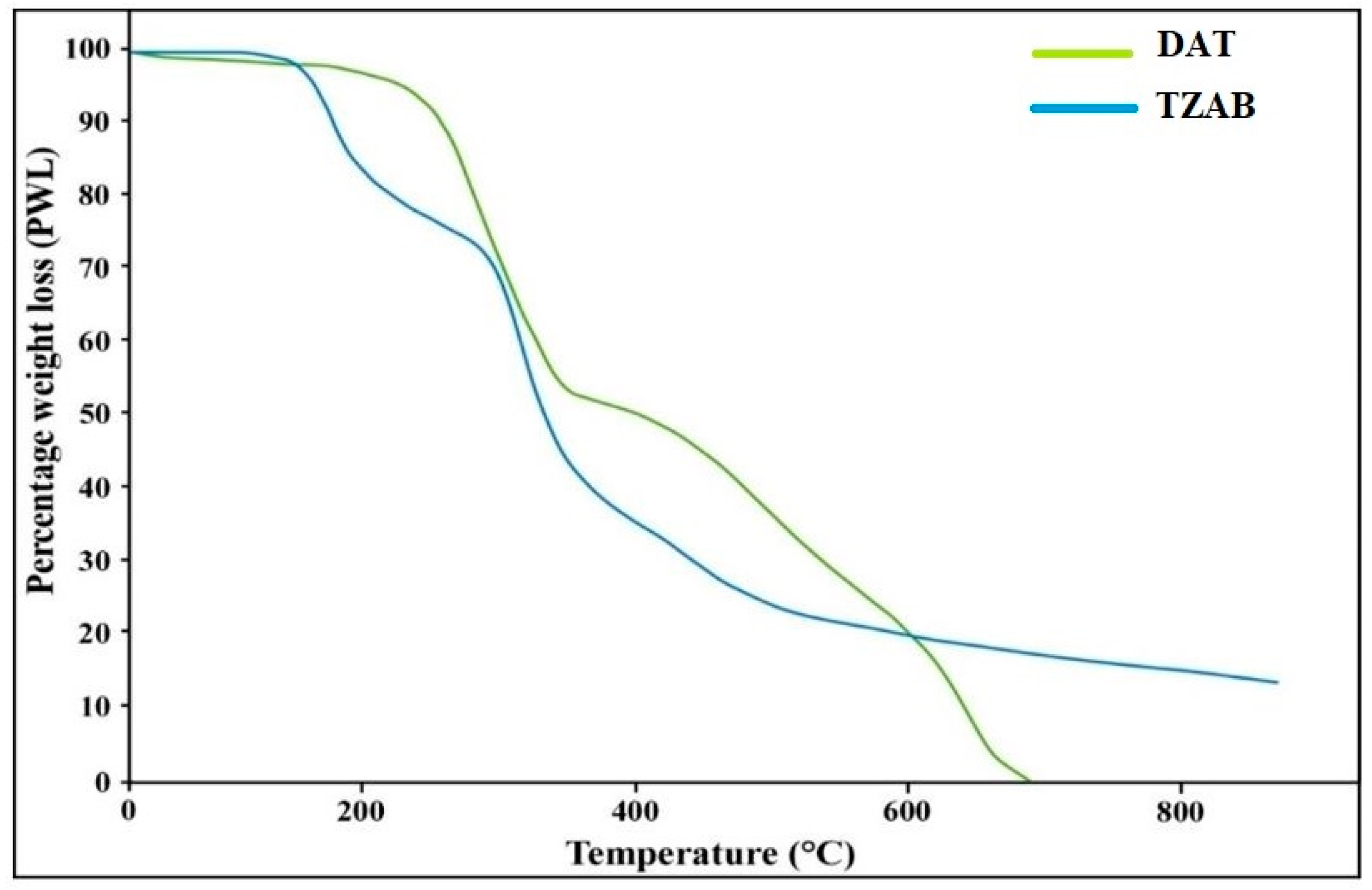

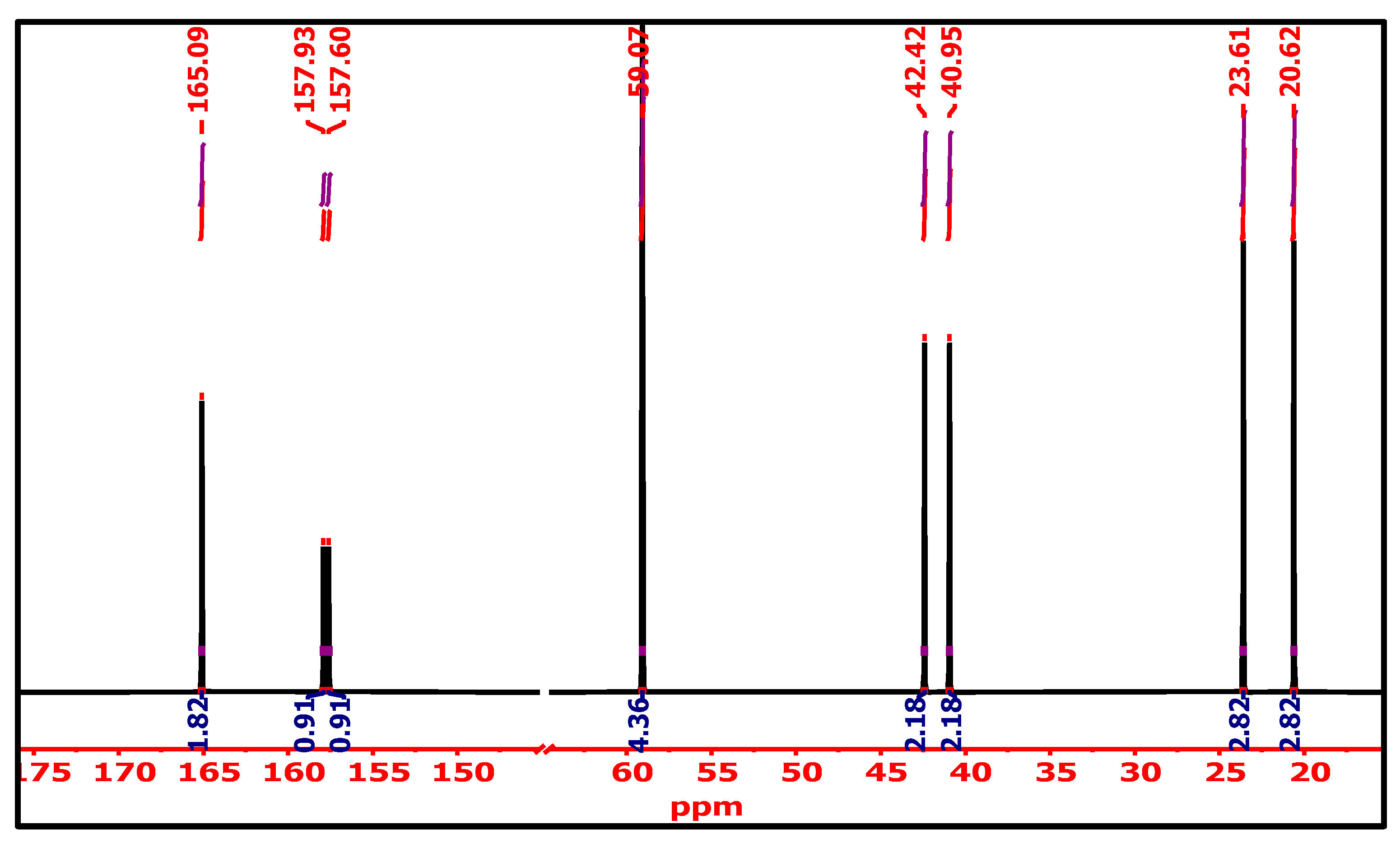



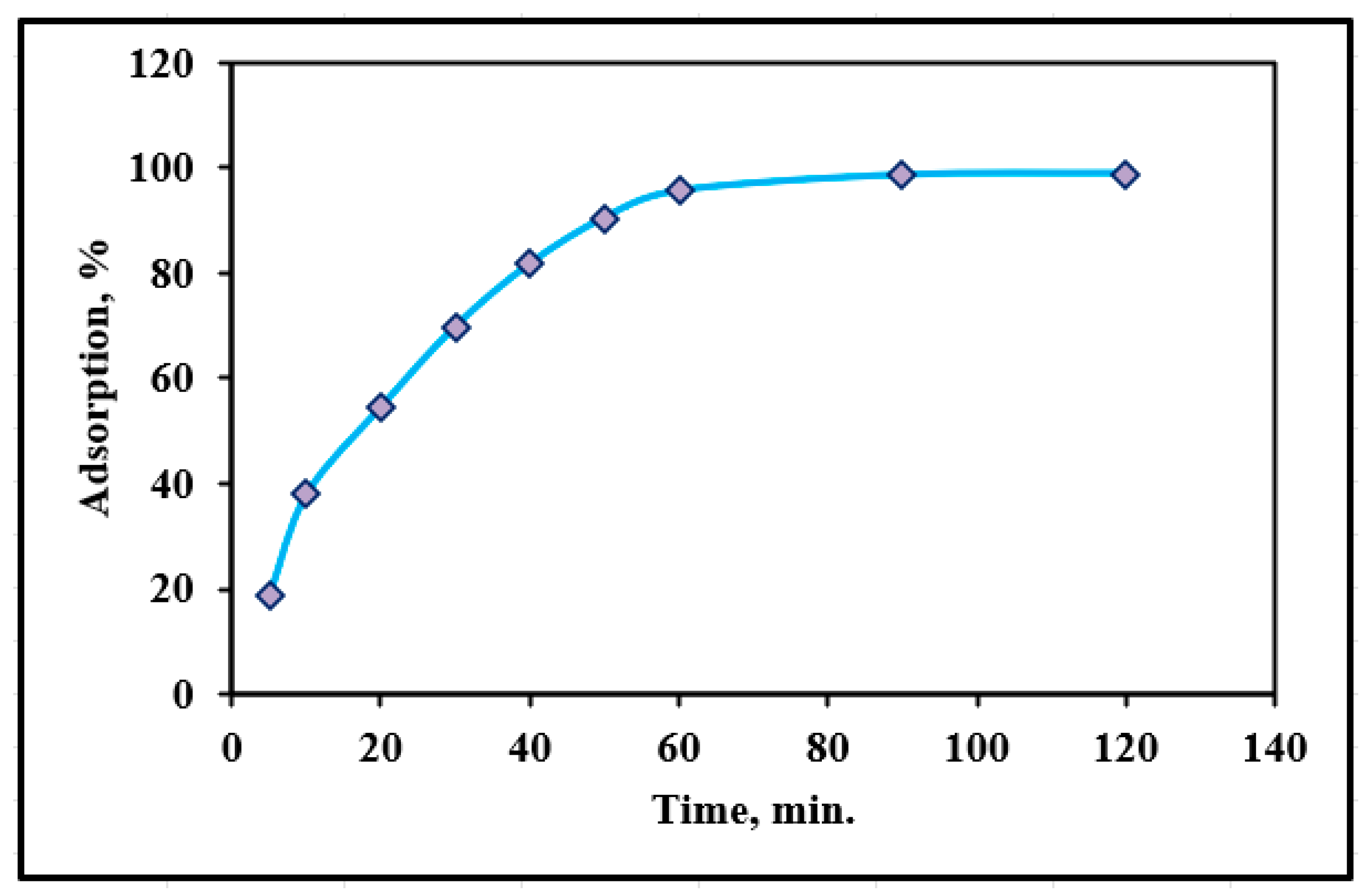
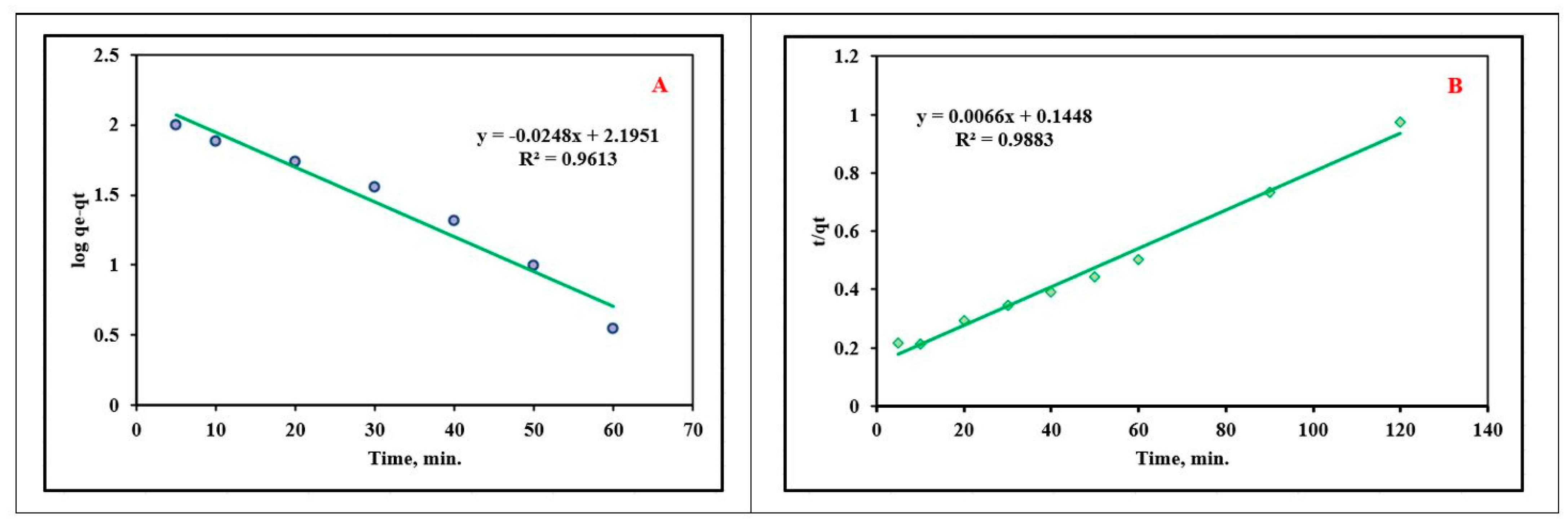



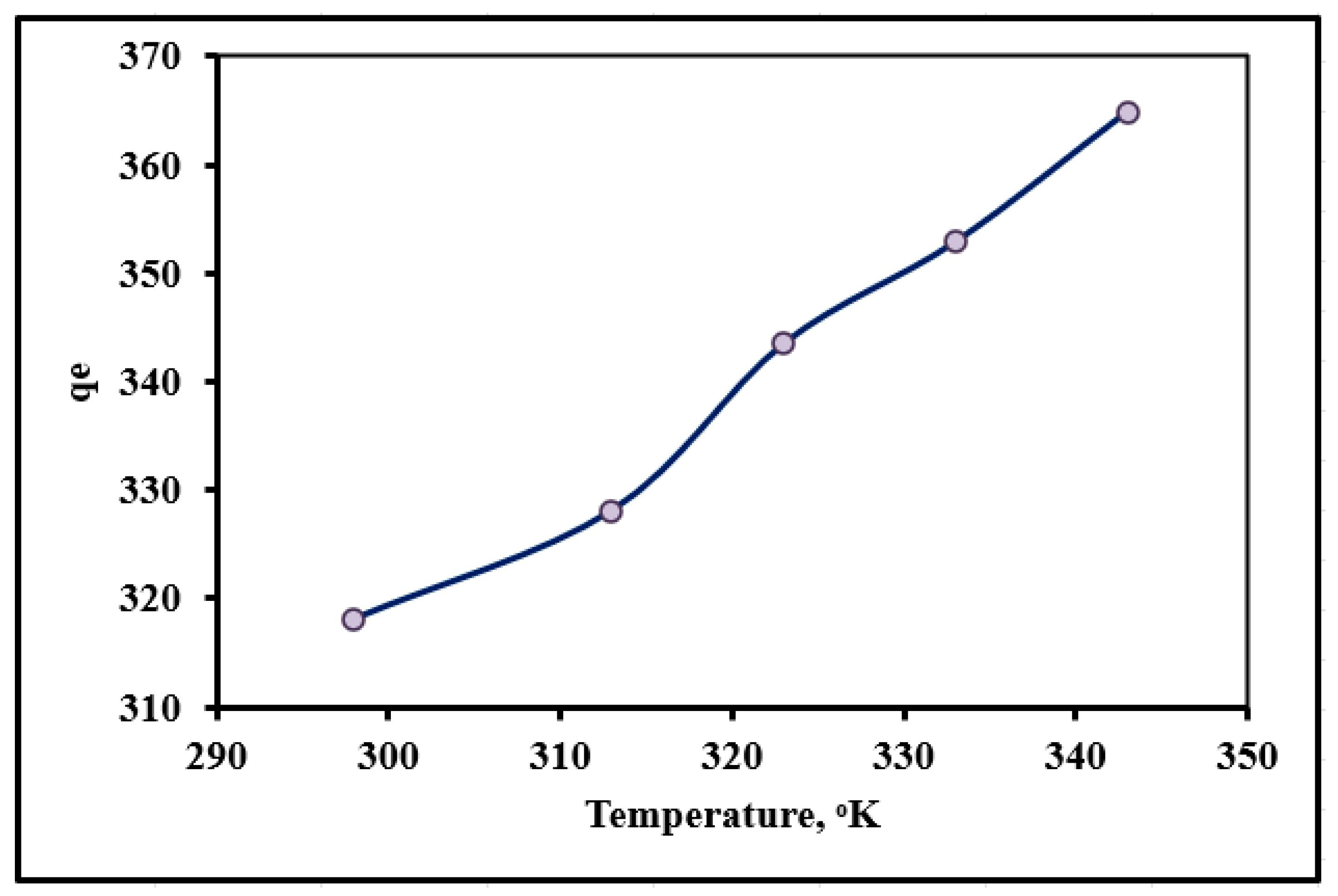
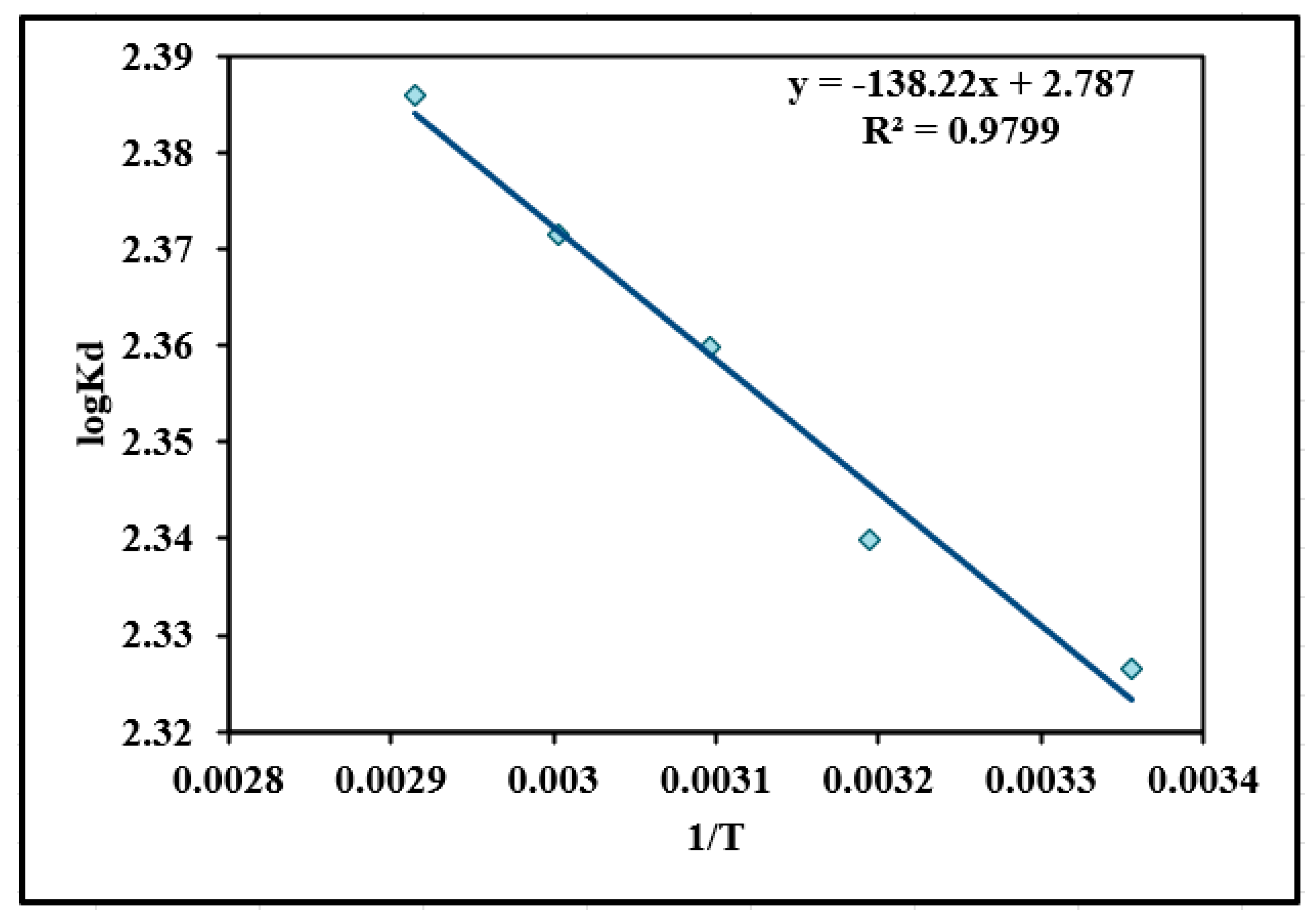
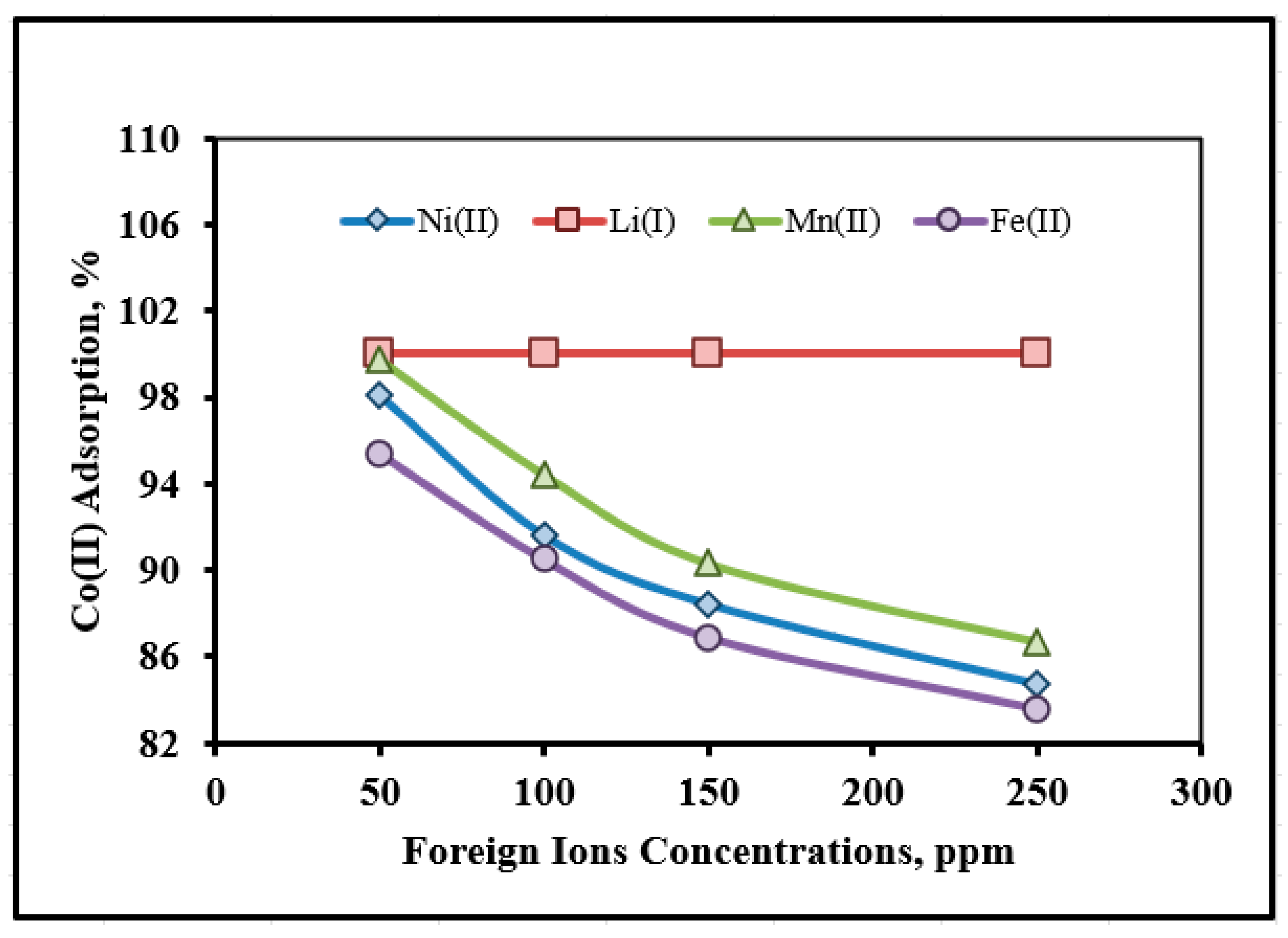
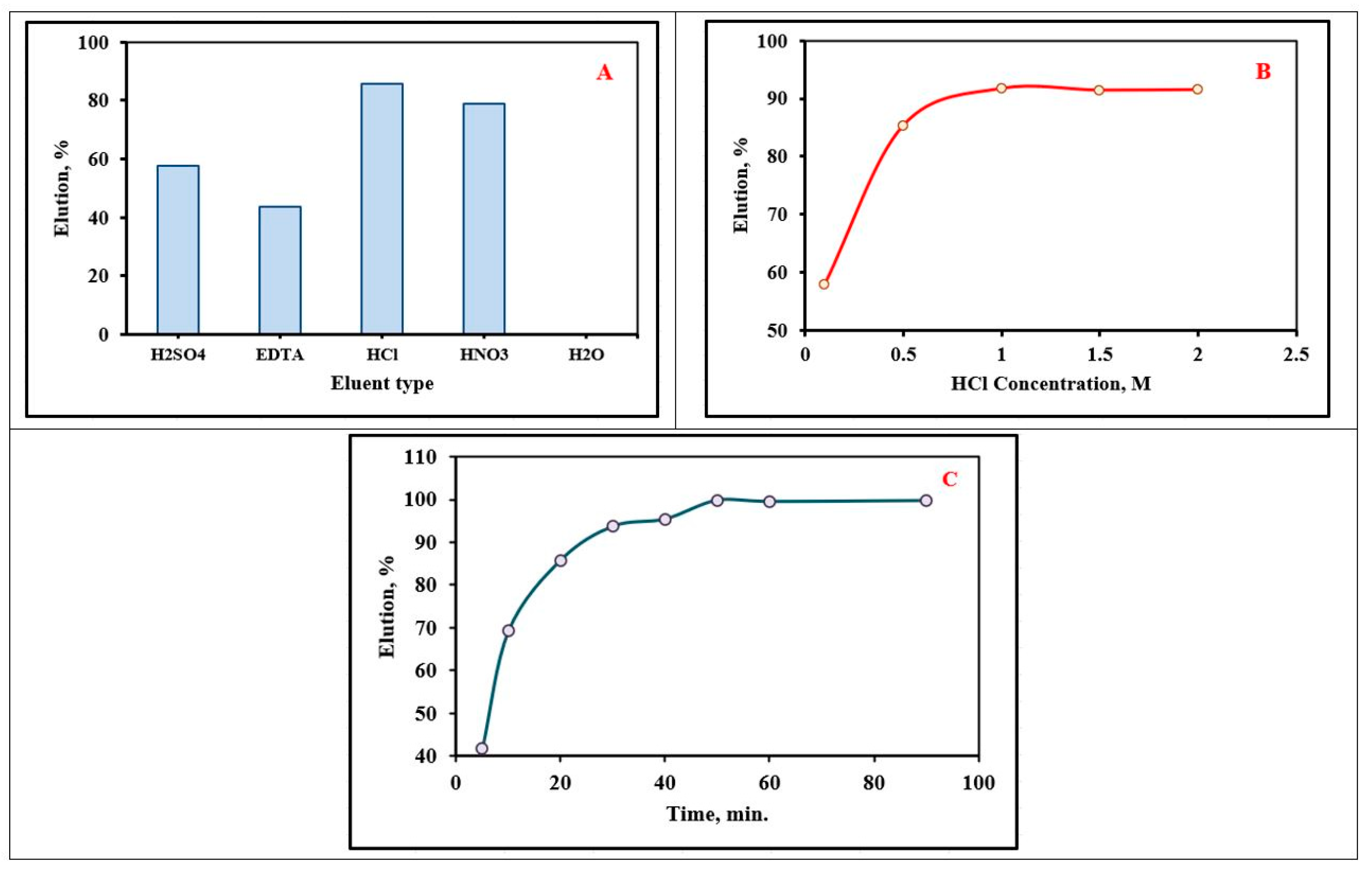



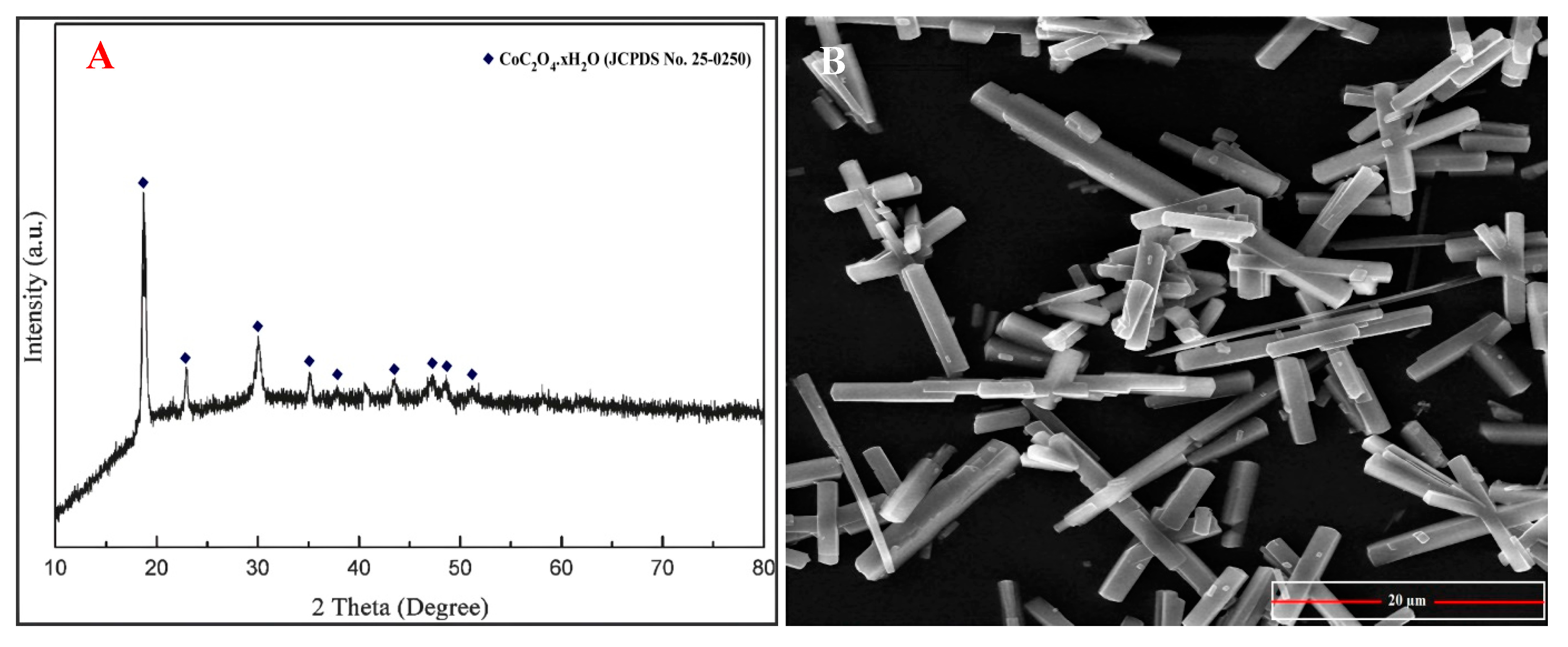
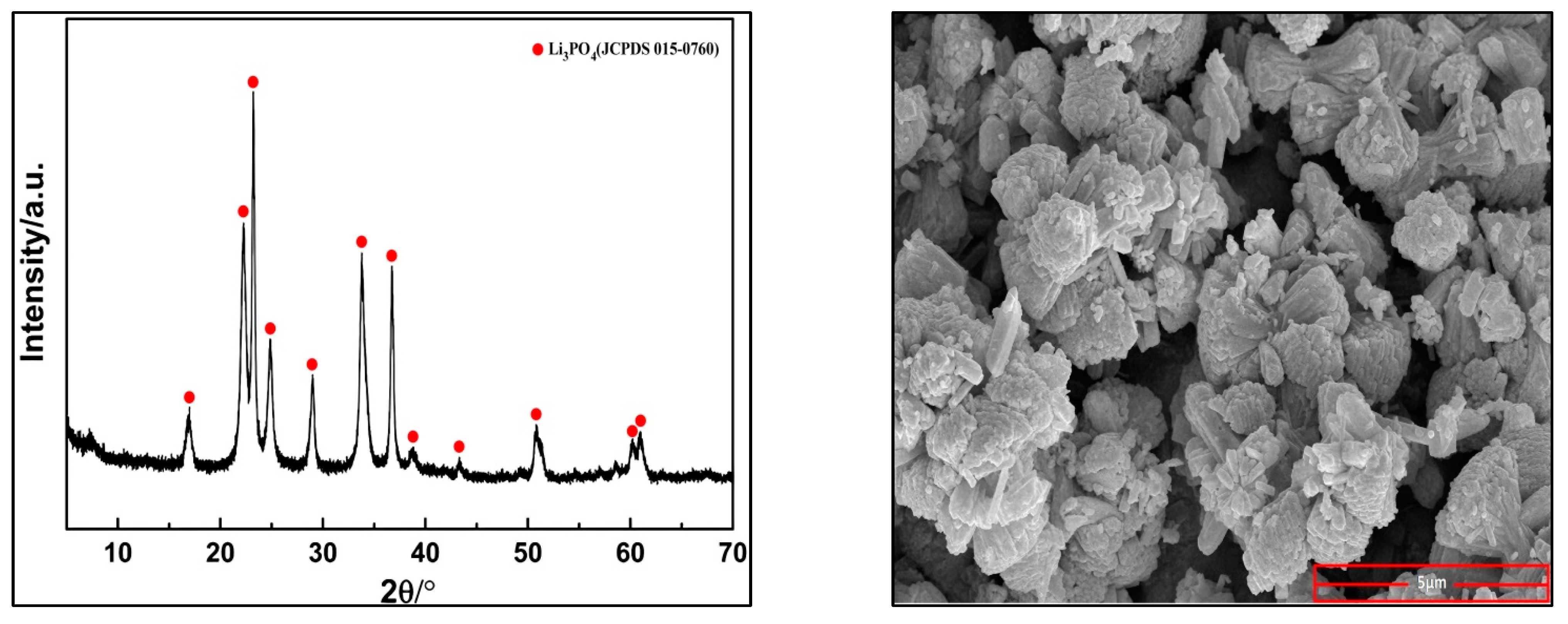
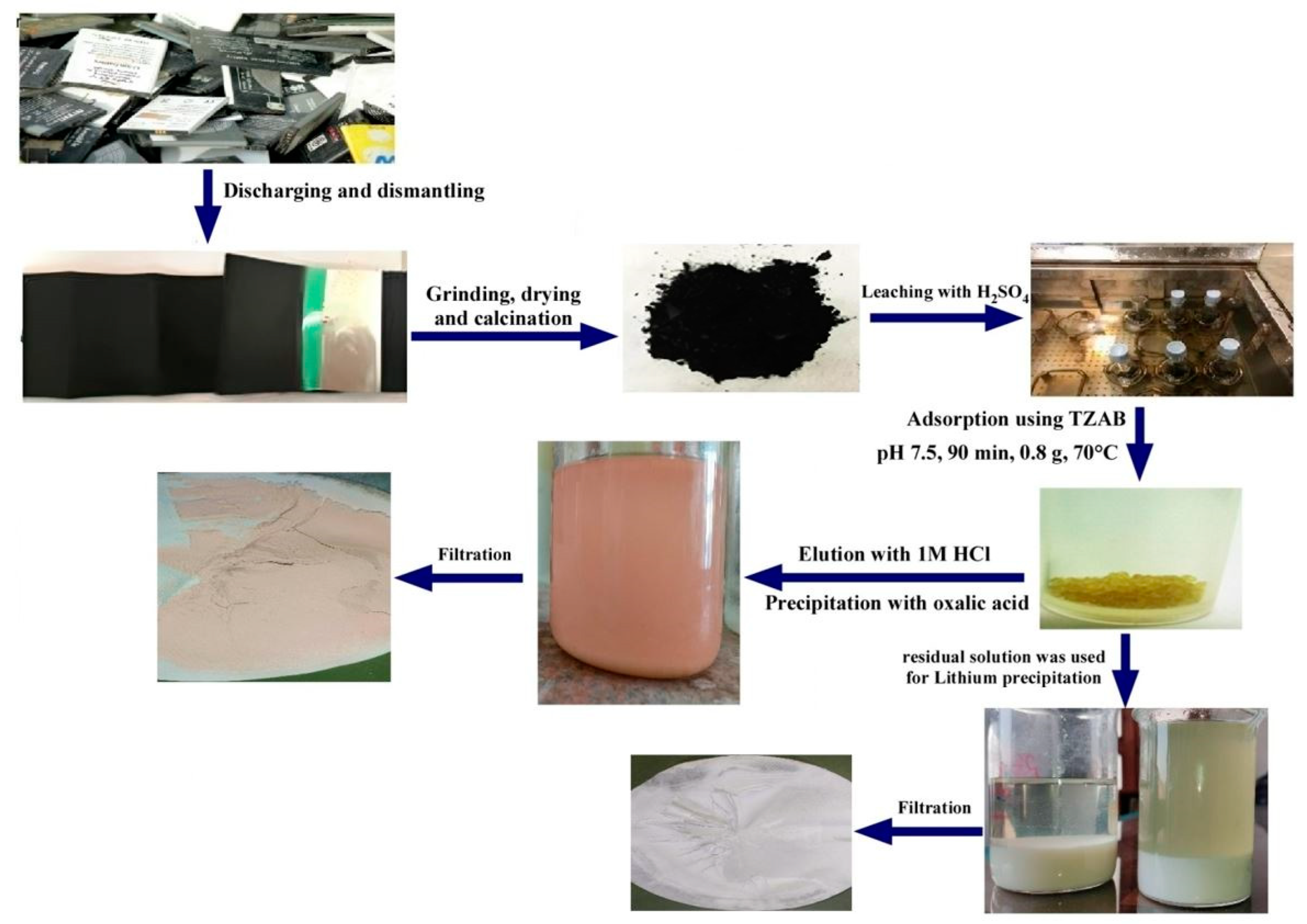
| 1st Order Kinetic | 2nd Order Kinetic | |||||
|---|---|---|---|---|---|---|
| K1 | q(max)cal | R2 | qmax(exp) | K2 | q(max)cal | R2 |
| 0.0571 | 156.711 | 0.9613 | 123.1 | 0.0004 | 128.21 | 0.9883 |
| Kinetic Models | Parameters | |
|---|---|---|
| Langmuir isotherm | Equation | y = 0.0031x + 0.0504 |
| qmax (mg/g) | 322.58 | |
| K1 | 0.06151 | |
| R2 | 0.9912 | |
| Freundlich isotherm | Equation | y = 0.2483x + 1.8154 |
| Kf (mg/g) | 65.373 | |
| 1/n (mg min/g) | 0.2483 | |
| R2 | 0.9334 | |
| D-R isotherm | Equation | y = −0.0058x + 5.7958 |
| qD (mg/g) | 328.915 | |
| BD (Mo12/KJ2) | 0.0058 | |
| ED (kj/mo−1) | 9.28477 | |
| R2 | 0.9541 | |
| Practical Capacity | qexp | 319.7 |
| ΔH° (kJ mol−1) | ΔS° (J mol−1 K−1) | ΔG° (kJ mol−1) | ||||
|---|---|---|---|---|---|---|
| 2.647 | 53.363 | 298 K | 313 K | 323 K | 333 K | 343 K |
| −13.26 | −14.06 | −14.59 | −15.12 | −15.66 | ||
| Adsorbent | mg·g−1 | Reference |
|---|---|---|
| Phosphorylated MWCNT-cyclodextrin/silver-doped titania | 7.81 | [56] |
| PTU-MS silica | 87.6 | [57] |
| Imprinted CTS-GPTMS-PTW | 22 | [58] |
| MCC- MH composite | 153.84 | [59] |
| MCS/AC@UiO-66 | 44.5 | [60] |
| Imprinted UiO-66-NH2 | 175 | [61] |
| Sulfurized activated carbon | 153.6 | [62] |
| Imprinted silica | 106 | [63] |
| Natural vermiculite | 49.5 | [64] |
| Imprinted mesoporous silica | 181.7 | [65] |
| Magnesium hydroxide powders | 125 | [66] |
| Magnetite-alginate nanoparticles | 33.6 | [67] |
| Triazol Schiff base derivatives (TZAB) | 319.7 | Current study |
| Metal | Li | Co | Al | Mn |
|---|---|---|---|---|
| Content (wt.%) | 5.83 | 46.98 | 0.04 | 0.02 |
Disclaimer/Publisher’s Note: The statements, opinions and data contained in all publications are solely those of the individual author(s) and contributor(s) and not of MDPI and/or the editor(s). MDPI and/or the editor(s) disclaim responsibility for any injury to people or property resulting from any ideas, methods, instructions or products referred to in the content. |
© 2023 by the authors. Licensee MDPI, Basel, Switzerland. This article is an open access article distributed under the terms and conditions of the Creative Commons Attribution (CC BY) license (https://creativecommons.org/licenses/by/4.0/).
Share and Cite
Mahran, G.M.A.; Gado, M.A.; Fathy, W.M.; ElDeeb, A.B. Eco-Friendly Recycling of Lithium Batteries for Extraction of High-Purity Metals. Materials 2023, 16, 4662. https://doi.org/10.3390/ma16134662
Mahran GMA, Gado MA, Fathy WM, ElDeeb AB. Eco-Friendly Recycling of Lithium Batteries for Extraction of High-Purity Metals. Materials. 2023; 16(13):4662. https://doi.org/10.3390/ma16134662
Chicago/Turabian StyleMahran, Gamal M. A., Mohamed A. Gado, Wael M. Fathy, and Amr B. ElDeeb. 2023. "Eco-Friendly Recycling of Lithium Batteries for Extraction of High-Purity Metals" Materials 16, no. 13: 4662. https://doi.org/10.3390/ma16134662
APA StyleMahran, G. M. A., Gado, M. A., Fathy, W. M., & ElDeeb, A. B. (2023). Eco-Friendly Recycling of Lithium Batteries for Extraction of High-Purity Metals. Materials, 16(13), 4662. https://doi.org/10.3390/ma16134662








